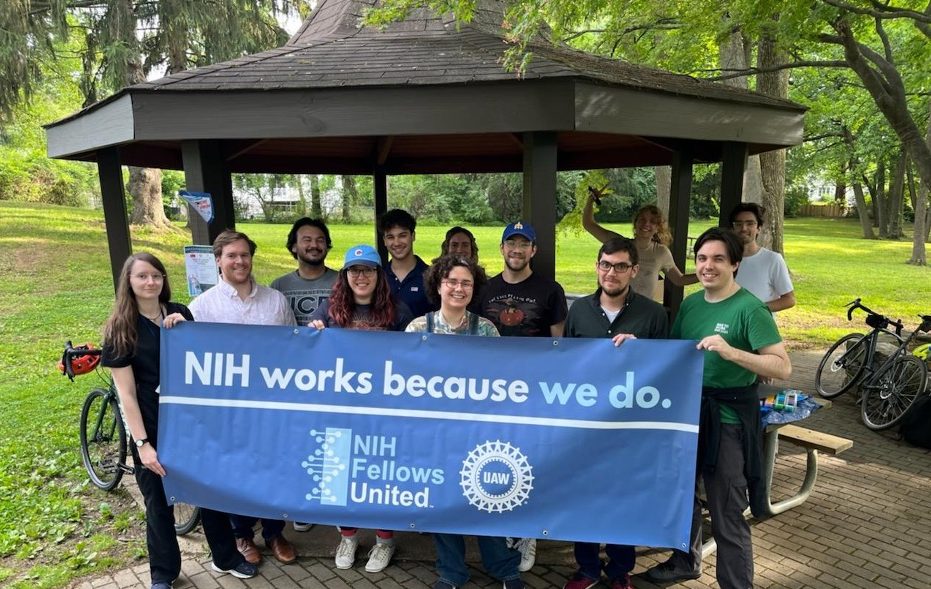The leadership of the UAW is offering a concise outline of the union’s demands in upcoming contract talks with General Motors, Ford and Stellantis, including the end of the tiered wage structure for new hires, and restoration of cost-of-living and job security guarantees to protect workers through the transition to electric vehicles.
“We’re going into the negotiations with clear priorities,” UAW President Shawn Fain says on Zoom during a “Town Hall” discussion of the contract covering more than 140,000 union members. “We must fight to end tiers. We must fight to restore cost-of-living protections and we must get stronger job protection guarantees.
“The union will not make any concessions,” adds Fain (pictured, below left).
 Current contracts between the UAW and the Detroit Three automakers expire Sept. 14. Departing from so-called pattern bargaining, in which contract terms negotiated between the UAW and one automaker are applied to the other two, this year’s talks will be held concurrently.
Current contracts between the UAW and the Detroit Three automakers expire Sept. 14. Departing from so-called pattern bargaining, in which contract terms negotiated between the UAW and one automaker are applied to the other two, this year’s talks will be held concurrently.
The union says it is demanding a contract which repays active and retired members for their sacrifices over the years.
Rich Boyers, the UAW vice president in charge of negotiations with Stellantis, says one of the union’s priorities is eliminating the eight-year grow-in period that now applies to new hires.
It is not uncommon for younger employees to work “10-12 years” first as a temporary employee and then as a new hire within the contractual wage progression before reaching full pay, says Fain, who in March won the union’s first presidential election in which members voted for top UAW officers.
Fain notes by the time a young worker reaches full pay, they often are deeply in debt.
Ending tiers also will mean blocking Detroit automakers’ efforts to create a new separate tier with lower wages for workers employed in electric-vehicle and battery plants, says Mike Booth, the UAW vice president responsible for negotiations with GM.
At the Ultium battery plant in Lordstown, OH, where the union is negotiating a contract for 1,200 workers, GM and its partner LG Energy now start workers at $16.50 per hour and pay $20 per hour after seven years.
Such a wage structure is unacceptable since the company is receiving billions of dollars in federal subsidies, Booth says. Instead, he says the union intends to return the fundamental principle of equal pay for equal work, which was part of the UAW’s historic contract with GM in 1937.
The principle of equal pay for equal work also means restoring pensions and post-retirement health care for new employees. Retirement and post-retirement benefits were sharply reduced in contracts the union signed during the auto industry bailout era more than 10 years ago.
During contract negotiations this summer, the union will ask for guarantees of a “secure landing place” for workers displaced by the transition to EVs, which don’t need the transmissions or internal-combustion engines now built by UAW members.
The union also wants to restrict the use of temporary workers and the movement of work to limited liability corporations, which blunts union influence over wages.
Chuck Browning, the UAW vice president responsible for the Ford negotiations, says the union not only will demand raises in any agreement this year but also will demand cost-of-living increases to protect members from inflation. COLA was added to union contracts in 1946 but was removed in 2009 and the buying power of members’ wages has declined since then, he says.
Unlike in 2019 when the union’s leadership was dogged by a corruption scandal, the UAW’s leadership seem determined to change the messaging around the upcoming contract talks.
Fain says over the past decade union members have made substantial sacrifices to make GM, Ford and Stellantis profitable. While the three automakers operate globally, much of their profits come from the U.S.
Detroit automakers have combined to make nearly a “quarter trillion dollars” in profits since 2013, Fain contends, while UAW members have seen their wages and standard of living erode.
To add some perspective to the quarter-trillion-dollar figure, the automakers’ profits are substantial enough to purchase – at current prices – every franchise in the NHL, NBA and Major League Baseball and “still have $50 billion left over,” Fain says.
The UAW also represents workers in the industry’s most profitable segments since Detroit’s automakers sell 81% of pickup trucks and 71% of fullsize SUVs (pictured, below). The average price of a vehicle built by UAW members is more than $55,000, which exceeds the average price of a new vehicle reported by the U.S. Department of Commerce, Fain says.

“The choice of whether we go out on strike is up to the Big Three,” Margaret Mock, the UAW’s new secretary-treasurer, says during the livestreamed meeting with members.
“We will go to the limit to get what we need,” Mock says, adding the union has $825 million in its strike fund. The 40-day strike against GM in 2019 cost the automaker $10.7 billion in lost revenue and $3.7 billion in profits.
Fain also mentions a recent ruling by the U.S. Supreme Court that unions can be held liable for damage to company property during a strike.
“While corporate America cheers on another Supreme Court attack on workers’ rights, this ruling achieves nothing that would undermine the fundamental right to strike,” says. “Our members’ fight for justice on and off the job won’t be slowed by a court ruling or by corporate greed.
“While we’re disappointed to see the U.S. Supreme Court once again try to legislate away the rights of working-class Americans, the UAW remains ready to take action, when necessary, to raise the standard for workers everywhere,” Fain says.
The UAW, however, received a lift this week when more than 4,100 researchers at the National Institute of Health in Bethesda, MD, filed petitions to join the UAW (pictured, below), strengthening the union’s foothold among workers employed in the field of advanced technology.






